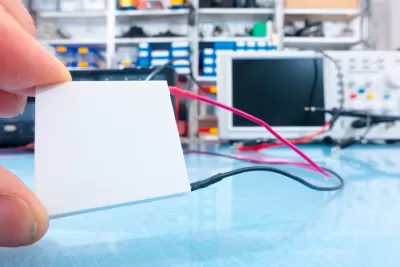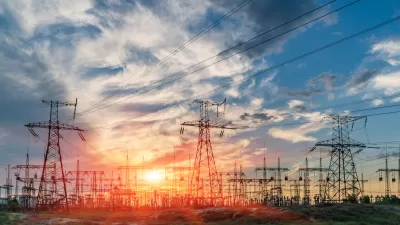Heat from industrial installations and buildings can be captured to create renewable electricity.

Scientists are working to develop devices that can harness waste heat from buildings and industrial uses to produce energy. As Muhammad Muddasar explains in The Conversation, most existing thermoelectric materials used to make such devices contain cadmium, lead, or mercury, toxic and often expensive substances.
Muddasar and other researchers at the University of Limerick and the University of Valencia have discovered a way to use wood-derived materials to convert waste heat. “This approach not only enhances energy efficiency, but also redefines how we view everyday materials as essential components of sustainable energy solutions.”
The research team used lignin, a byproduct of the paper industry, to convert low-temperature waste heat into electricity. “Since around 66% of industrial waste heat falls within this temperature range, this innovation presents a significant opportunity for eco-friendly energy solutions.”
In addition to capturing energy, thermoelectricity also requires storage solutions. Lignin-based porous carbon can also be used in supercapacitors to store energy. According to Muddasar, “This technology could find use in various settings, from providing power in remote areas to powering sensors and devices in everyday applications.”
FULL STORY: How waste heat could be captured and converted into green energy

Alabama: Trump Terminates Settlements for Black Communities Harmed By Raw Sewage
Trump deemed the landmark civil rights agreement “illegal DEI and environmental justice policy.”

Planetizen Federal Action Tracker
A weekly monitor of how Trump’s orders and actions are impacting planners and planning in America.

Why Should We Subsidize Public Transportation?
Many public transit agencies face financial stress due to rising costs, declining fare revenue, and declining subsidies. Transit advocates must provide a strong business case for increasing public transit funding.

Understanding Road Diets
An explainer from Momentum highlights the advantages of reducing vehicle lanes in favor of more bike, transit, and pedestrian infrastructure.

New California Law Regulates Warehouse Pollution
A new law tightens building and emissions regulations for large distribution warehouses to mitigate air pollution and traffic in surrounding communities.

Phoenix Announces Opening Date for Light Rail Extension
The South Central extension will connect South Phoenix to downtown and other major hubs starting on June 7.
Urban Design for Planners 1: Software Tools
This six-course series explores essential urban design concepts using open source software and equips planners with the tools they need to participate fully in the urban design process.
Planning for Universal Design
Learn the tools for implementing Universal Design in planning regulations.
Caltrans
Smith Gee Studio
Institute for Housing and Urban Development Studies (IHS)
City of Grandview
Harvard GSD Executive Education
Toledo-Lucas County Plan Commissions
Salt Lake City
NYU Wagner Graduate School of Public Service





























